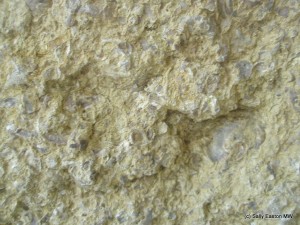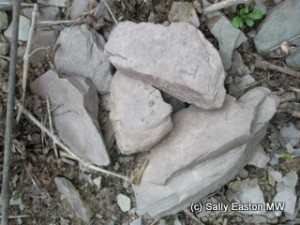Describing minerality

Chablis rocks
A version of this article was first published in the March 2013 issue of Drinks Business magazine.
Since the first DB piece on minerality was published in 2009, research into the subject has been gathering pace, with new findings emerging.
Dr Jordi Ballester, oenology lecturer and researcher at the University of Bourgogne started undertaking lexical analysis that year – analysing French and English language tasting notes to see if any clusters of words and wines turned up – work which is ongoing. He said “the minerality topic was taking on a strange importance everywhere. We suspected that it was getting too big all of a sudden in a few years, because a while ago, only a few regions claimed the idea of minerality, and it stayed local. For example, warmer climate regions never claimed minerality and now it seems everyone wants to claim it. But wine has not changed that much; people have changed.”
He pointed out that minerality is absent from both Peynaud’s book ‘The taste of wine’ (1983), and Ann Noble’s wine aroma wheel (1984). This vaguely coincides with Kumeu River’s Michael Brajkovich’s first encounters with the word in early 80s Roseworthy (Australia) and late 80s France.
In 2010 Ballester started sensory analysis from which results showed that experts simply don’t agree on minerality. There were some shared words when freely describing minerality immediately after some blind tasting exercises. He said “cues such as fresh, acidic, the smell of stones, salty, seashore, chalky things. Actually they described not that many ideas, and the ones that everyone thinks.” But in the tasting prior to their defining the term, the results show no trends or correlation. No agreement at all. He said “my impression was a lower disagreement in the declared definition than the level of disagreement in the tasting.” There should be no surprise by this result, minerality means different things to different people, and the industry lacks consistency of interpretation and communication about minerality.
He’s now working on Chablis wines. Chablis is one of the regions long associated with the concept of minerality. Indeed Ballester’s lexical work has already revealed that of all the French wine notes (from Hachette plus Bettane and Desseauve) describing Burgundy chardonnays as mineral, more than half of the total are from Chablis.
The next project, starting with the 2013 vintage, is to identify if Chablis “producers consistently think every year a type of soil gives minerality”. Ballester will get grapes from these sites to perform uniform micro-vinifications, and get grapes from sites that express no minerality to test his hypotheses. He said “if minerality is in the grapes, the must will already be mineral. If minerality is created during fermentation then we smell and taste the wines.”
 Minerality coming directly from the minerals (nutrients) in the ground remains something that’s impossible to happen. Professor Alex Maltman, of the Institute of Geography and Earth Sciences at the University of Wales said “although the notion that minerality is the taste of vineyard minerals still sweeps all before it, I have further reasons for saying that minerality is not literally the taste of vineyard minerals. Whatever it is, it’s indirect.” He explained “I have more analytical data corroborating mineral elements in wine are incredibly small. Even potassium rarely exceeds a few hundred parts per million (ppm) with a few tens of ppm for calcium and magnesium; most of the rest, such as the metals copper and zinc, are in parts per billion.” Additionally he said “these are tasteless anyway, and their concentrations in wine are below sensory thresholds measured in water.”
Minerality coming directly from the minerals (nutrients) in the ground remains something that’s impossible to happen. Professor Alex Maltman, of the Institute of Geography and Earth Sciences at the University of Wales said “although the notion that minerality is the taste of vineyard minerals still sweeps all before it, I have further reasons for saying that minerality is not literally the taste of vineyard minerals. Whatever it is, it’s indirect.” He explained “I have more analytical data corroborating mineral elements in wine are incredibly small. Even potassium rarely exceeds a few hundred parts per million (ppm) with a few tens of ppm for calcium and magnesium; most of the rest, such as the metals copper and zinc, are in parts per billion.” Additionally he said “these are tasteless anyway, and their concentrations in wine are below sensory thresholds measured in water.”
Picking up on the Chablis theme Maltman said “I’ve come up with a couple of terms that people use from time to time and which do relate to the soil, and which are measurable. Things I can analyse for, it’s there or it isn’t.” He’s collected a range of tasting notes for Chablis which include tastes to do with the sea, in particular iodine about which he said “I can analyse for iodine”. He did. Vineyard soils in Chablis, the wines and vine leaves are all low in iodine. Mmm. He said “geological minerals cannot take up iodine easily, nor can land plants (such as the vine). I wouldn’t expect much iodine”, and indeed the wines tested are remarkably low, “lower than other chardonnays” he said. It’s not looking good for iodine as a proxy indicator of minerality in Chablis, then.
Another theme that Maltman warms to is that of vapour pressure. “For us to smell something, it has to vaporise. It has to be vapour, not solid. Things such as alcohol and esters volatilise easily and we can smell some of these aromatics in parts per trillion. But something solid such as iron doesn’t turn to vapour under normal conditions. It has no smell.” But organic compounds can vaporise relatively easily, so, he said “I would agree that stones can take on a smell if they were dry and it rains. But the rain triggers the release of organic compounds from the thin film of organic matter on the stones and it is this that we smell. We’re not smelling the stone.”
Sticking with volatility is a theory that minerality comes from volatile thiols, for example the smoky, gunflint notes often associated with sauvignon blanc come from benzenemethanethiol.
This thiol is one incorporated into an extensive international project at the universities of Burgundy and Bordeaux II, and New Zealand, being overseen by Dr. Wendy Parr, sensory scientist at Lincoln University in New Zealand. It is looking at a multi-modal description of perceived minerality in sauvignon blancs from France and Marlborough, New Zealand, i.e. a description that encompasses smell, taste and texture, with textural aspects including acidity and freshness. They looked at connections between perceived minerality and reduction, various multi-modal descriptors, analysing many physical and chemical compounds and minerals to identify any statistical association with mineral descriptions (work yet to be published).
Over various researches in recent years Parr has noted a change of heart regarding Marlborough sauvignon blanc, from mineral having a negative connotation to the current positive attribution, which the team is investigating further. She said “we have no solid data to say a shift has occurred … In our early studies (2003-4 vintages) there were virtually zero reports of the term ‘mineral’ or its sub-components [flint, chalk, silex, oyster shell, iodine (!)]. In the 2007 paper, wines judged higher in ‘mineral’ were rated low in Marlborough typicality and varietal definition [fruity and green notes].” By 2011, other work showed that some wines with a high level of minerality were also judged as being high in Marlborough typicality. That’s less than a decade for people to have changed, as Ballester suggested.
The research is exploring a possible link for this change of heart about the perception of minerality becoming a positive attribute for Marlborough sauvignon blanc, and those reductive thiols (smoky, gunflint, rubbery). Parr explained “the increased use of the term ‘mineral’ in relation to wine here in NZ parallels the increased use of screwcaps which some argue has produced many more wines exhibiting low levels of reductive notes. That these reductive notes in low concentrations might be perceived as ‘mineral/smoky’, etc. could be one answer to the question why the term mineral appears more frequently now in New World wine-judging terminology than it did a decade ago.” All the NZ sauvignon blancs in the study were closed with screwcap.
When comparing the French and New Zealand sauvignon blancs in the latest work, using 2010 vintage wines, Parr said “French and NZ wines are rated similarly in intensity of ‘mineral’ note … with liking more driven by intensity of fruit and green characteristics.” These fruit and green notes include the varietal thiols of 3MH (passionfruit, grapefruit) and 3MHA (grapefruit, passionfruit, boxwood), and the methoxypyrazine IBMP (green pepper). Parr added “the flavour notes (fruity, green) overall oppose the mineral/acidity notes … the general pattern seems to be that wines judged lower in the fruity and green flavour notes, are more likely to be judged as mineral.” With the additional types of data gathered in this study Parr hopes to unravel the apparent contradiction that NZ wines were also described as more fruity even though they were described as similarly mineral to the French wines.
The research is showing that perception of minerality is, indeed, multi-modal. Parr said “perception of mineral was evidenced in all three situations in our study, i.e. nose-only, full tasting and palate-only (taste and touch, a nose-clip was used).” She added “the greatest separation appears to have occurred in the nose-only condition, which goes against some wine producers’ arguments that mineral cannot be smelled.” There is also a link between perceived minerality and perceived higher acidity. Further work is being done.
Exhaustive analysis of many mineral elements in the wines has just begun with early results suggesting there are some differences between the French and Marlborough wines. Concentrations of magnesium, potassium, calcium, sodium, rubidium, strontium, aluminium, iron, manganese, silicon, lanthanum, phosphorus, sulphur, barium, copper, molybdenum, nickel and zinc have been calculated and Parr hopes to report the specific differences soon.
Any link between mineral element concentrations and perception of minerality sounds a bit like searching for the holy grail, but it’s important our scientists pursue this to its natural positive or negative conclusion.
Technical table
| Category | Shorthand | Longhand | Aroma |
| VSC (implicated in reduction +/or perceived minerality link?) | DMS | Dimethyl sulphide | Quince, truffle |
| Ditto | H2S | Hydrogen sulphide | Rotten eggs |
| Ditto | Methanethiol | Stagnant water, halitosis | |
| Ditto | Ethanethiol | Onion, rubber | |
| Ditto | Diethyl sulphide | Ether | |
| Ditto | DMS | Dimethyl disulphide | Quince, asparagus |
| Varietal thiols in sauvignon blanc (linked with typical fruity notes) | 3MH | 3-mercaptohexan-1-ol | Passionfruit, grapefruit |
| Ditto | 3MHA | 3-mercaptohexyl acetate | Box, broom |
| Ditto | 4MMP | 4-mercapto-4-methylpentan-2-one | Box, broom |
| Other thiols measured | E2SA | Ethyl-2-sulfanylacetate | Baked beans |
| Ditto | BMT | Benzenemethanethiol | Flinty/mineral |
| Methoxypyrazine | IBMP | Isobutyl methoxypyrazine | Green pepper |
Source: compiled from various sources
Comments
2 Responses to “Describing minerality”




August 17, 2013 at 9:37 pm
Very informative piece! Can you tell, in basic terms, what the difference is (as it pertains to wine) between organic and inorganic minerality?
August 18, 2013 at 10:36 am
How about we can get minerality sorted before we start to subdivide it?